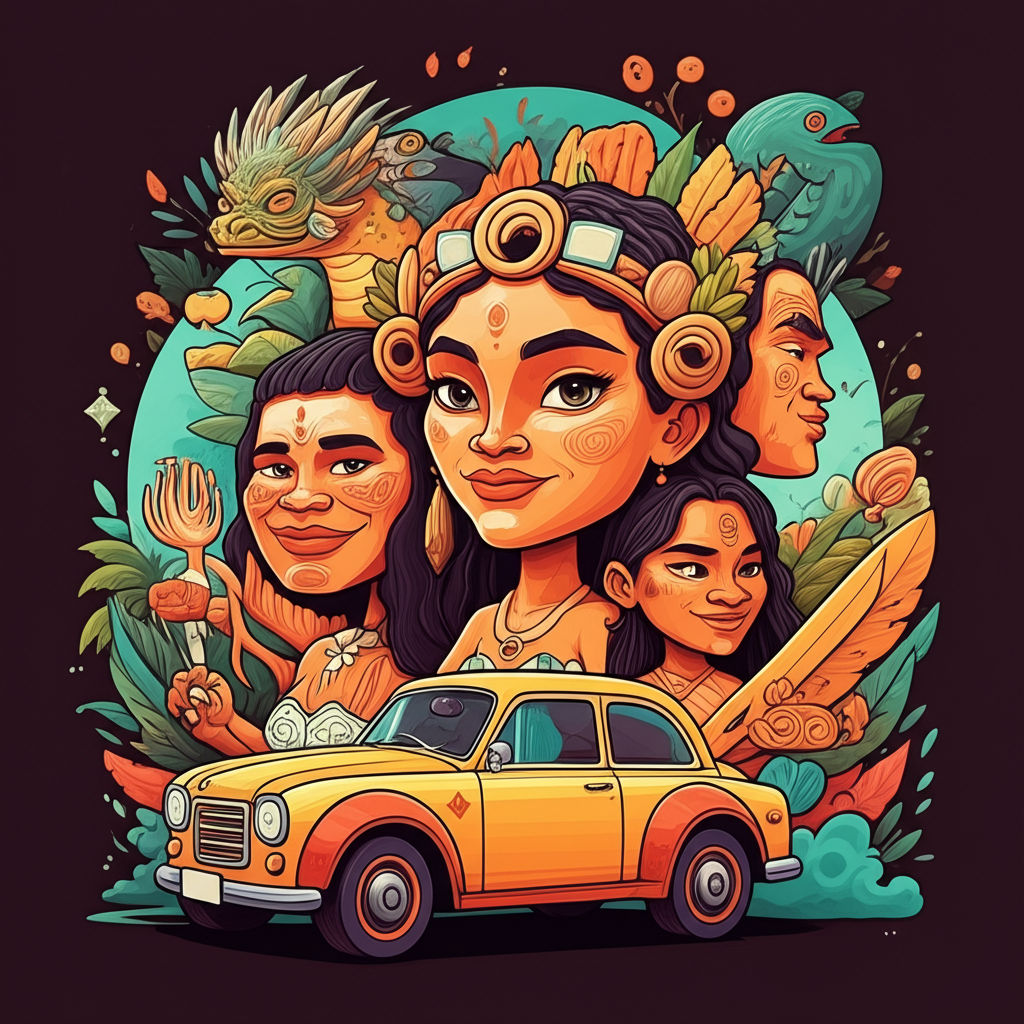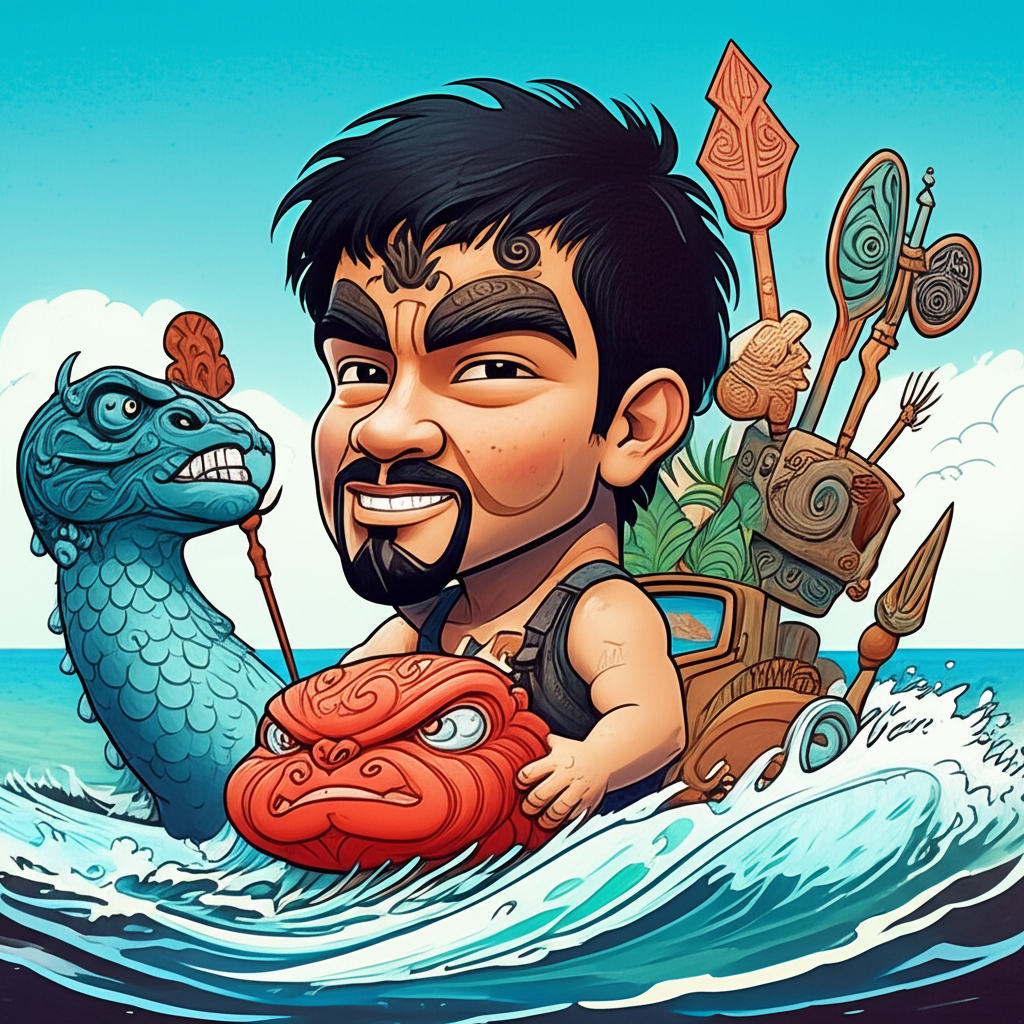
1. Introduction: Threads of Ancient Wisdom
Across the vast, shimmering expanse of the Pacific Ocean, where emerald islands rise from sapphire depths, ancient peoples wove intricate narratives that explained their world. Among these cherished traditions is a powerful cycle of myths stemming from Polynesian cultures, particularly vibrant in Hawaiian and Māori lore, echoing themes of creation, transformation, and ancestral ties. This article delves into the legendary tapestry of "Echoes of Hina – Mo’o – Hawaiki," a traditional story told by ancient people, offering a window into their worldview and cultural values. It is presented solely for cultural, historical, and educational understanding, not as a belief system to be adopted or practiced.
2. Origins and Cultural Background: Navigating a Mythic Sea
This myth originates from the heart of ancient Polynesia, a cultural era marked by extraordinary seafaring prowess, deep reverence for nature, and a vibrant oral tradition. For the inhabitants of these scattered islands—navigator-explorers who charted courses by stars and currents—the world was a living entity, imbued with spiritual force. Their society was intimately connected to the land (ʻāina) and the sea (moana), understanding that every element, from the towering volcano to the smallest shell, possessed a spirit or mana.
People of that time viewed the world through an animistic lens, believing that deities, spirits, and powerful beings inhabited the natural landscape. The islands themselves were seen as manifestations of divine power or the bodies of ancestors. Life was a constant interplay between humanity and these powerful forces, governed by cycles of nature, ancestral wisdom, and the will of the gods. Stories like that of Hina, the Mo’o, and the ancestral homeland of Hawaiki served not merely as entertainment, but as vital guides for living, teaching lessons about courage, respect, interconnectedness, and the profound journey of existence.
3. Character / Creature Description: Beings of Myth and Metaphor
Within this rich mythological landscape, three elements stand central to our narrative: Hina, the Mo’o, and Hawaiki. These are not real entities but symbolic representations of powerful concepts.
-
Hina: A figure revered across many Polynesian traditions, Hina often embodies the moon, weaving, creative arts, and feminine power. She is depicted as beautiful, strong, and sometimes rebellious, associated with cycles of renewal, fertility, and light. In some tales, she is a goddess of the moon, sailing across the night sky; in others, she is a human woman of great wisdom and resilience who overcomes challenges. Her symbolic attributes include the cycles of nature, particularly the lunar phases, artistic creation, feminine strength, and the power of transformation. She represents the nurturing, creative, and sometimes challenging aspects of existence.
-
Mo’o: These are mythical reptilian beings, often described as colossal lizards or dragons, present in various forms throughout Polynesian folklore. Mo’o are formidable and ancient, capable of shapeshifting, sometimes appearing as beautiful women or handsome men to lure unsuspecting mortals, or as immense, fearsome beasts. They are frequently guardians of sacred places, particularly freshwater springs, fishponds, and significant land features. While some Mo’o are benevolent protectors, others are predatory and dangerous, embodying the wild, untamed, and sometimes perilous forces of nature. Their symbolic attributes include guardianship, the duality of protection and danger, shapeshifting (representing change and illusion), and the raw, untamed power of the natural world.
-
Hawaiki: Not a character or creature, but a profoundly significant place—the mythical ancestral homeland for many Polynesian peoples. Hawaiki is the spiritual source, the land of origin from which the ancestors set sail on their epic voyages of discovery. It is often described as a place of immense spiritual power, where the veil between worlds is thin, and where the spirits of the departed eventually return. Hawaiki is not a single, fixed geographical location but rather a concept representing roots, identity, spiritual connection, and the collective memory of an entire people. Symbolically, Hawaiki embodies ancestral connection, the journey of origin and return, the source of cultural identity, and the spiritual wellspring of life.
4. Main Story / Narrative Retelling: Hina’s Quest for the Echoes of Hawaiki
The air in ancient Hawaiʻi was thick with the scent of salt and plumeria, and the rhythm of the waves was the heartbeat of the islands. It was here, amidst the vibrant flora and volcanic peaks, that the tale of Hina, the Mo’o, and the echoes of Hawaiki began to unfurl. Hina, known for her luminous beauty and her mastery of kapa-making—a skill that captured the very essence of light and shadow in woven cloth—often felt a deep, inexplicable yearning. Though she thrived on her island home, a persistent whisper in her soul spoke of Hawaiki, the ancestral homeland, a place her people had only known through the oldest chants and dreams.
One day, Hina declared her intention: she would seek out the living echoes of Hawaiki, not necessarily a physical return, but a spiritual connection to the source of her being, a way to imbue her artistry with the purest ancestral mana. Her journey led her to the heart of the deepest valley, where the most sacred freshwater springs bubbled forth, believed to be veins of the Earth connected to the very pulse of Hawaiki. Legend held that these springs were guarded by a formidable Mo’o, a colossal lizard-being named Kaimana, whose scales shimmered like obsidian and whose eyes held the wisdom of ages.
As Hina approached the shimmering pool, the ground trembled. From the depths, Kaimana emerged, vast and ancient, its presence commanding the very air. Its voice, a rumbling echo of distant thunder, filled the valley: "Who dares approach the sacred waters, where the breath of Hawaiki lingers?"
Hina, though awed, stood tall. "I am Hina, daughter of this land, and I seek to understand the whispers of my ancestors, to connect with the spirit of Hawaiki. I come not to take, but to learn, to honor."
Kaimana regarded her with an intensity that pierced her soul. "Many seek Hawaiki, Hina, but few understand that it is not merely a place, but a state of being. To touch its essence, one must prove worthy of its memory. I am its guardian here. You must weave a kapa so pure, so imbued with intention, that it captures the light of the moon, the wisdom of the stars, and the enduring spirit of Hawaiki itself. If you fail, the waters will forever deny you their secrets."
For days and nights, Hina worked tirelessly. She gathered the finest wauke bark, soaked it in the sacred waters, and beat it with rhythmic precision. As she worked, she chanted the ancient genealogies, recalling the names of her forebears who had sailed from Hawaiki. She dyed the kapa with pigments derived from the Earth, each color a prayer, each pattern a story. She wove in the crescent moon, a symbol of her namesake, and the stars that had guided her ancestors. But most profoundly, she imbued it with her yearning, her respect, and her deep connection to the lineage that stretched back to the mythical homeland.
When the kapa was finished, it glowed with an ethereal light, shimmering with the wisdom of the ages and the resilience of a people. Hina presented it to Kaimana. The great Mo’o, after a long, silent inspection, bowed its mighty head. "You have woven not merely cloth, Hina, but the very spirit of Hawaiki. You have shown that its essence lies not in a distant land, but within the heart, the hands, and the memory of its descendants. The waters are open to you."
As Hina touched the spring, a profound sense of peace washed over her. She felt the echoes of countless generations, the wisdom of the ocean, and the enduring spirit of Hawaiki, not as a faraway place, but as a vibrant, living force within her. She had not physically returned to Hawaiki, but she had reconnected with its spirit, allowing its mana to flow through her, enriching her art and her soul.
5. Symbolism and Meaning: Lessons from the Ancestors
This narrative, like many traditional myths, is rich with symbolism and profound meaning for the ancient people.
- Hina’s Journey: Represents the human quest for identity, connection to ancestry, and the enduring power of creative expression. Her resilience and artistry symbolize the ability to overcome challenges through skill, wisdom, and spiritual fortitude.
- The Mo’o, Kaimana: Embodies the powerful, often untamed forces of nature that guard sacred knowledge and places. Kaimana’s challenge represents the trials and tests one must face to gain deeper understanding or access to spiritual truths. It also highlights the duality of nature—both protective and formidable.
- Hawaiki: Symbolizes the profound importance of origin, lineage, and cultural memory. It emphasizes that true connection to one’s roots is not merely geographical but spiritual and cultural, residing within the individual and the collective consciousness.
- The Kapa: Represents the power of cultural arts as a vessel for history, spirituality, and identity. Hina’s weaving signifies that human creativity, when infused with reverence and intention, can bridge the gap between the mundane and the sacred, between the present and the ancestral past.
- Overall Message: The myth teaches that true connection to one’s heritage (Hawaiki) requires an inner journey and a respectful engagement with the natural world (Mo’o), guided by wisdom and creative spirit (Hina). It underscores the importance of honoring one’s origins and finding strength in ancestral memory.
6. Modern Perspective: Enduring Resonance
Today, the echoes of Hina, Mo’o, and Hawaiki continue to resonate powerfully in contemporary Polynesian culture and beyond. While no longer literal beliefs for most, these myths serve as foundational narratives for cultural identity and revitalization movements.
In literature, these figures inspire contemporary authors and poets exploring themes of heritage, environmentalism, and cultural resilience. In film and media, elements like powerful shapeshifting guardians and ancestral homelands are often referenced or reimagined, even if not directly portraying these specific figures. For example, the spirit of seafaring, reverence for ancestors, and connection to the land and sea, found in films like Disney’s Moana, draw deeply from the broader mythological framework of the Pacific, where figures like Hina and the Mo’o once reigned supreme in oral traditions.
Academically, these myths are studied for their linguistic, anthropological, and historical insights, offering invaluable data about ancient Polynesian migrations, societal structures, and spiritual practices. Culturally, they are celebrated in dance, music, art, and storytelling festivals, ensuring that the wisdom and imagination of the ancestors continue to enrich new generations, reminding them of their unique heritage and their profound connection to the Pacific.
7. Conclusion: The Enduring Power of Story
The narrative of Hina, Mo’o, and Hawaiki is a testament to the enduring human need for stories—tales that explain the world, impart wisdom, and connect generations. It is a beautiful and intricate piece of cultural heritage, reflecting the deep spiritual and physical relationship the ancient peoples of Polynesia had with their environment and their history.
As Muslims, we recognize that only Allah (God) is the true Creator and Sustainer of the universe, and that all power and divinity belong to Him alone. This understanding allows us to appreciate such mythological narratives not as truths to be believed, but as fascinating expressions of human imagination and cultural identity. These stories, born from specific historical and geographical contexts, offer valuable insights into the ways different societies have sought to understand their existence, their origins, and their place in the world. They remind us of the universal human quest for meaning and the timeless power of storytelling to preserve heritage and inspire imagination across the ages.





